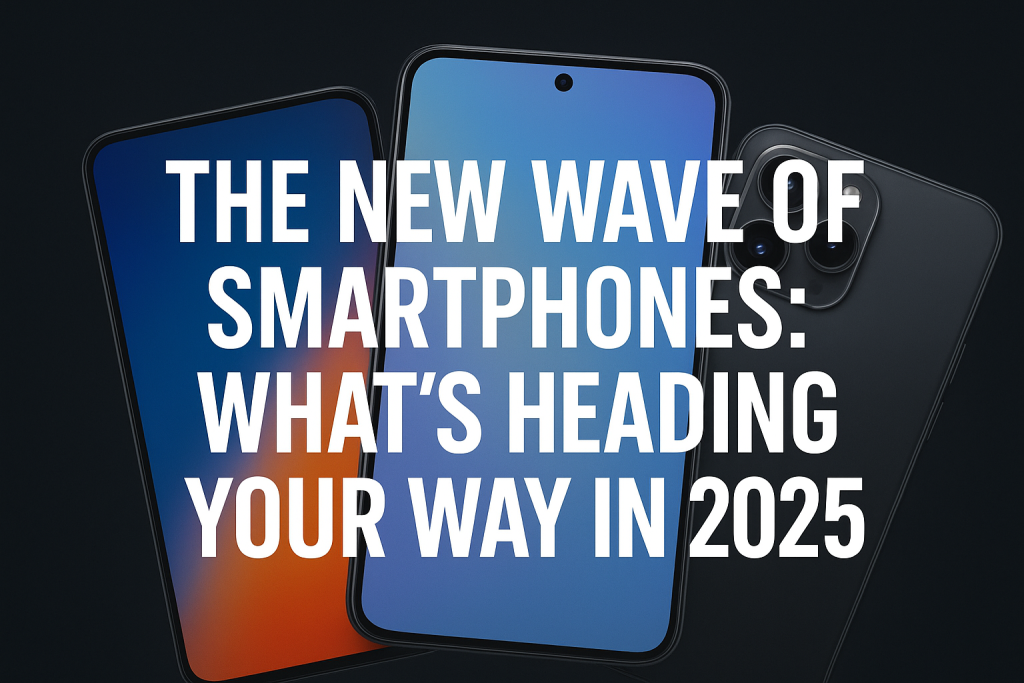The New Wave of Smartphones: What’s Heading Your Way in 2025
2025 is shaping up to be a transformative year in the smartphone landscape. As manufacturers race to integrate AI, foldable form factors, and multi-screen innovations, consumers will see devices that look familiar but behave in surprising new ways. Below is a roundup of the most notable new phones, key trends, and what to expect going forward.

Flagship Phones Getting Smarter: The AI Inflection Point
A defining shift this year is how deeply artificial intelligence is being embedded into phones. Samsung’s Galaxy S25 series, launched in early 2025, exemplifies this movement. The S25 line replaces Samsung’s own Exynos silicon in many markets with Qualcomm’s Snapdragon 8 Elite platform, which brings enhanced AI processing abilities. The phones also feature tighter integration with Google’s AI models (e.g. Gemini), enabling “personal concierge” style features that manage tasks, notifications, and context-aware suggestions.
Alongside hardware upgrades, Samsung has introduced a thinner sibling to the S25 lineup called the Galaxy S25 Edge, expected to launch globally on May 13, 2025. The Edge variant is among the skinniest Galaxy S phones yet, with strong emphasis on camera and design.
In China, Xiaomi’s 17 Pro / Pro Max models stand out by pushing multi-screen innovation. These models include a Dynamic Back Display, a small external screen built into the camera module, allowing users to preview selfies, display useful widgets, or even play mini-games. The Pro Max also sports a massive 7,500 mAh battery, fast charging (100W wired, 50W wireless), and a triple 50 MP camera setup—including a periscope telephoto lens for 5× optical zoom.
Honor is also leaning hard into AI. The upcoming Magic 8 Pro will reportedly include a dedicated AI button to trigger smart features, like one-sentence image re-stylings via a “Magic Color” tool. Honor has teased that the Magic 8 series will usher in a “Dual-Engine AI” architecture that balances power, memory, and efficiency.
Foldables, Mid-ranges & the Push for Design Innovation
While flagships grab headlines, the mid-range and foldable segments continue to evolve meaningfully.
Samsung’s Galaxy Z Flip 7 launched in July 2025 offers a refined clamshell foldable with a slimmer build, upgraded internals, and the latest Android and One UI software. Despite its compact folding form, the phone still packs powerful hardware—Exynos 2500 chip (3 nm), 12 GB RAM, and up to 512 GB of storage. It also promises seven Android upgrades, a bold move for longevity.
On the mid-tier front, Samsung introduced the Galaxy A56 5G earlier in 2025. It features a 6.7-inch AMOLED display, a 50 MP main camera with optical image stabilization, and a 5,000 mAh battery with 45 W wired charging. Samsung commits to six years of OS updates for this model—an unusually long support window in this class.
Another mid-level phone is the Samsung Galaxy A17 5G, announced mid-2025. While more modest in specs, it retains key features such as a 6.7-inch Super AMOLED display, 50 MP main camera (with OIS), and Android 15 out of the box. The A17 is also slated to receive six major software updates.
In the more niche space, Huawei’s Pura 80 series is making waves—especially the Ultra variant, which is rumored to include a 1-inch main sensor, dual periscope zoom capability, and a novel HDR mode called SuperPixGain HDR 2.0 for improved dynamic range. All models ship with HarmonyOS NEXT (HarmonyOS 5) as their base.
What These Trends Tell Us
- AI is now an expected pillar, not a luxury feature. From dedicated hardware to software hooks, every major brand is baking in intelligent automation, image understanding, context awareness, and predictive features.
- Multi-screen and unconventional displays are returning. The Dynamic Back Display on Xiaomi’s new phones shows that manufacturers are willing to experiment beyond foldables to give users fresh UX paradigms.
- Longevity matters more. It’s no longer unusual for mid-range phones to promise 5–6 years of OS support, putting pressure on manufacturers to commit to longer update cycles.
- Battery capacity and fast charging are still key battlegrounds. Whether for flagship or mid-range, big batteries (5,000–7,500 mAh) combined with higher wattage charging are essential to support AI workloads and extended usage.
- Design matters—thinness, build, and form factor are differentiators. Devices like the S25 Edge, Flip 7, and Magic 8 Pro show that manufacturers aren’t only competing on specs—they’re competing on aesthetics, industrial design, and how a phone feels in the hand.

The Road Ahead
Looking forward, expect to see even tighter AI-software-hardware coupling. As 5G evolves into 5G-Advanced and we edge toward early 6G concepts (via 3GPP’s Release 20), new networking capabilities will unlock further possibilities in real-time translation, cloud-assisted computation, and intelligent media processing.
Also, as more companies enter the foldable and multi-display arena, we may see hybrid form factors (e.g. foldables + external displays) become more popular. Battery innovation (solid state, faster charging) will also be critical to sustain these new computing workloads.
If you like, I can also send you a comparison table of the top five new phones in 2025 (specs + pros/cons). Would you prefer that next?